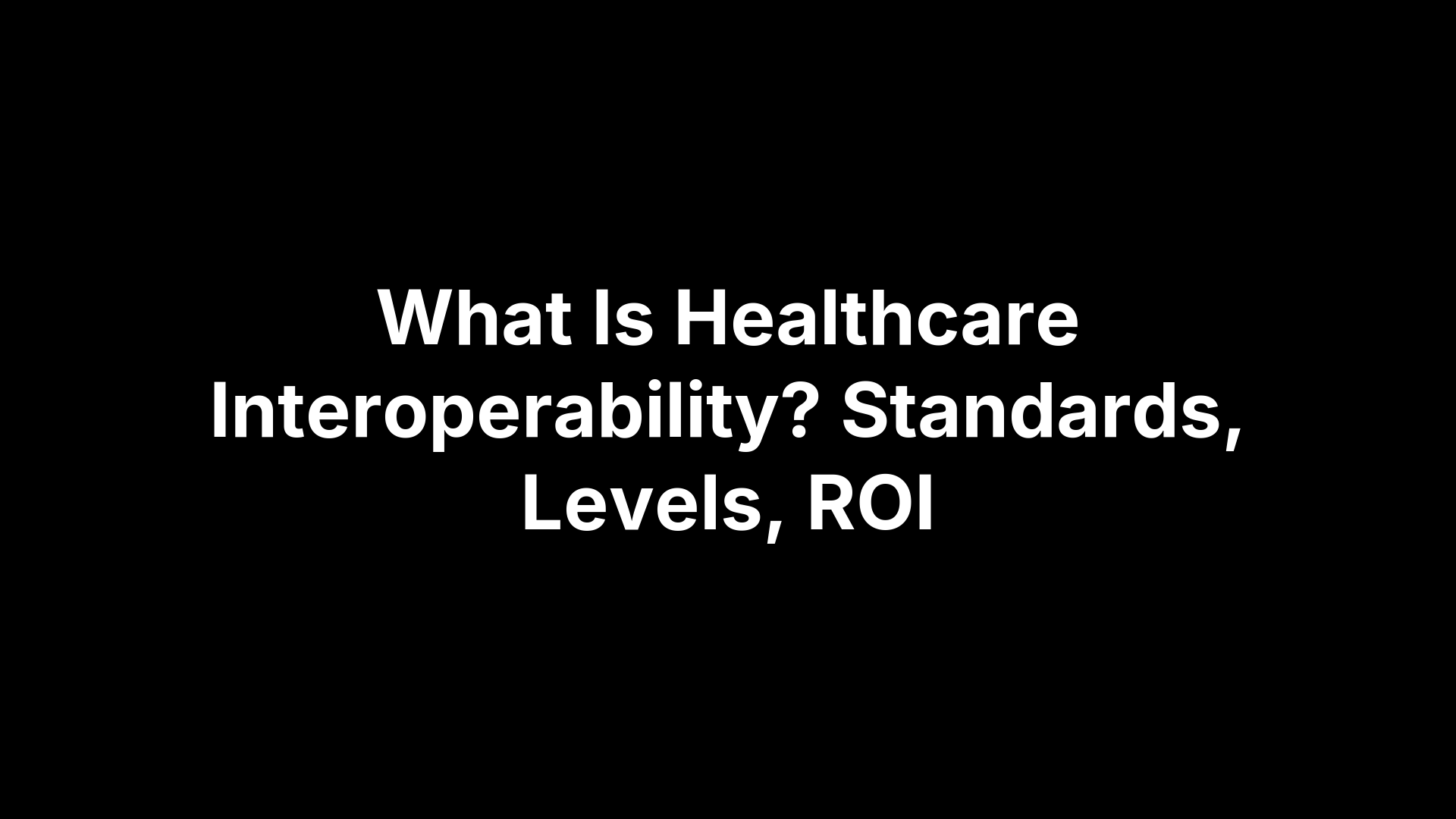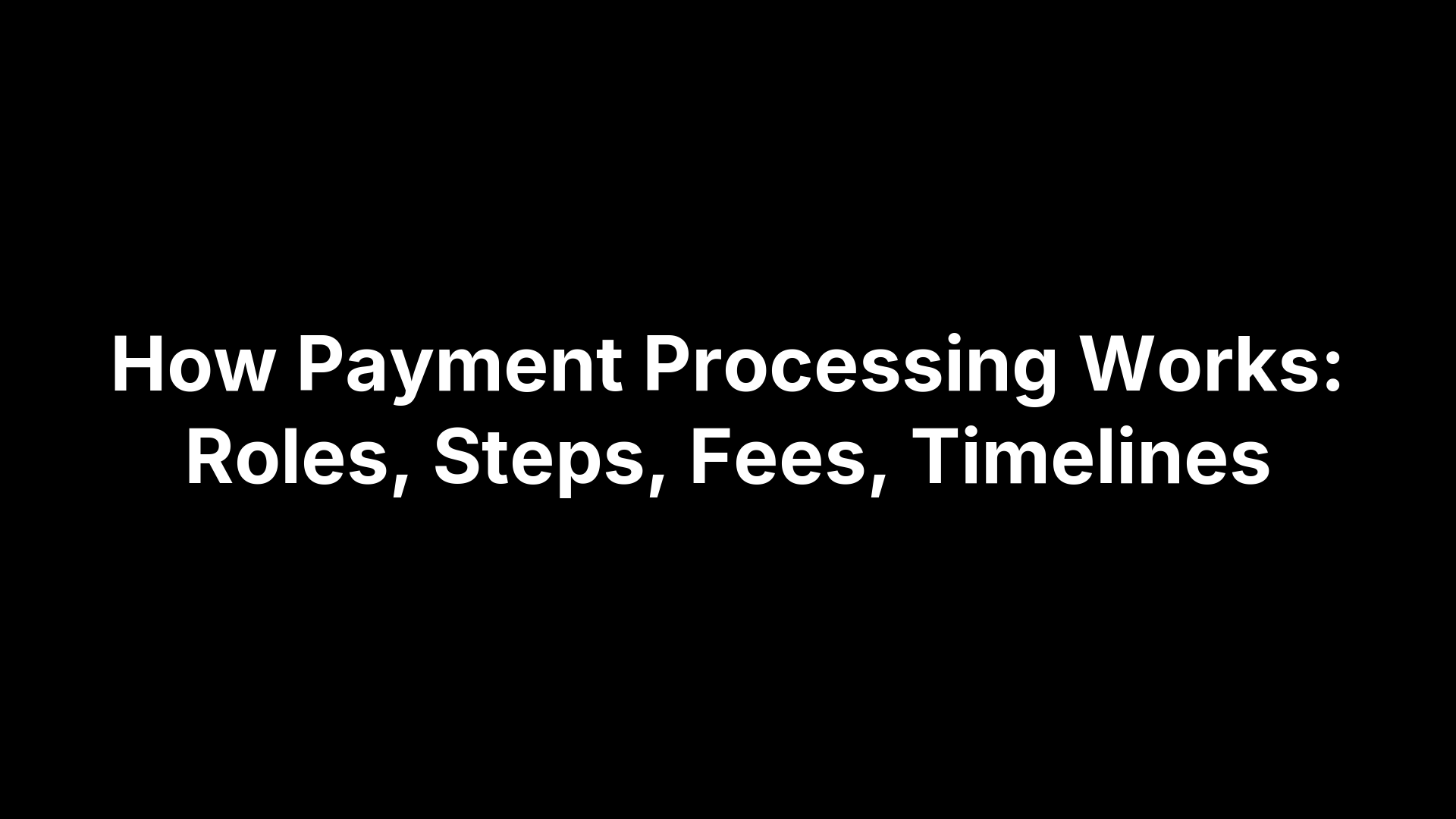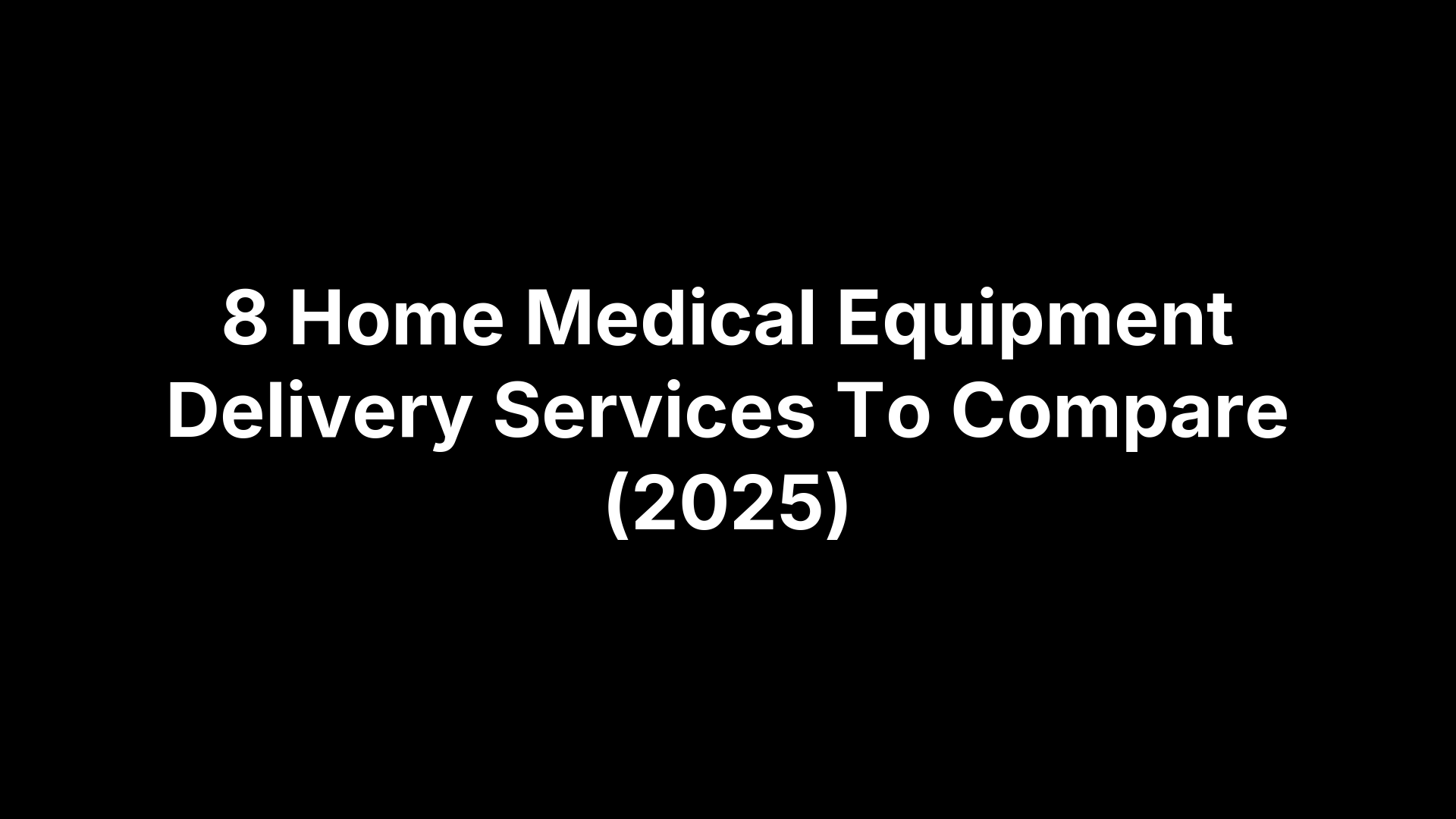EHR Integration Services: Compare Vendors, Features & Costs


EHR Integration Services: Compare Vendors, Features & Costs
EHR integration is where many healthcare IT projects bog down. Teams juggle Epic, Cerner, athenahealth, or a homegrown EHR alongside CAD/dispatch, billing, telehealth, CRM, and payer portals. Clinicians double-enter data, referrals stall, and discharges are delayed while transport, home care, or DME orders bounce between systems. Meanwhile, security and compliance raise the stakes, and budgets drift as scope and vendor dependencies expand.
The way through is a disciplined approach that anchors integration work to clinical and operational outcomes, not just interfaces. That means clarifying goals and KPIs, mapping real-world workflows, selecting the right standards (FHIR, HL7 v2, CCDA) and patterns (APIs, ESB), choosing a sourcing model, and comparing vendors with objective criteria. It also means de-risking via sandbox proof-of-concepts, setting governance and SLAs early, and designing for the logistics that move care forward—scheduling, orders/results, billing, and patient services like transport, home care, and DME.
This guide gives you a practical, step-by-step framework to plan, buy, and implement EHR integration services. You’ll see how to estimate timelines and costs with sample scenarios, build an RFP and vendor scorecard, evaluate middleware versus integration firms versus no-code and logistics platforms, and avoid common pitfalls. Use it as a checklist from strategy to go-live and ongoing support—and as a reference when you compare vendors, features, and total cost of ownership.
Step 1. Clarify your business goals, clinical outcomes, and KPIs
Before you compare EHR integration services, anchor the work to specific outcomes. Align operational leaders, clinicians, revenue cycle, and compliance on the problems to solve (e.g., discharge delays, duplicate entry, slow referrals), the target populations and workflows, and the measurable results you expect. Translate those into objective acceptance criteria (performance, availability, latency) and into a baseline-and-target plan for the first 90–180 days post‑go‑live.
- Operational KPIs: Scheduling time per order, referral‑to‑appointment time, order turnaround, handoff/communication touches.
- Clinical KPIs: Time‑to‑discharge readiness, avoidable readmissions, medication reconciliation completeness, closed‑loop results.
- Financial KPIs: First‑pass claim acceptance, denial rate, DSO, cost per transaction/integration point.
- Compliance/Security: Audit completeness, access exceptions, incident MTTR, policy adherence.
- User Experience: Task completion time, error rate, adoption/active usage, satisfaction (CSAT).
These goals and KPIs become the backbone of your RFP, vendor scorecard, and phased roadmap.
Step 2. Map your current systems, data flows, and workflow gaps
Great integrations start with a clear picture of what you already run and how work really gets done. Catalog your EHR(s), ancillary apps, CAD/dispatch, billing, telehealth, CRM, HIE, payer connections, and patient logistics (transport, home care, DME). Document real data flows and handoffs, not just SOPs, so you can see where duplicate entry, delays, and errors originate.
- Systems & owners: Name each system, environment, vendor, tech stack, and business owner.
- Interfaces & standards: Current protocols and specs (FHIR, HL7 v2, CCDA, custom APIs), plus constraints.
- Core data entities: Patient, encounter, orders/results, scheduling, claims; vocabularies (ICD‑10, CPT, SNOMED CT, LOINC, RxNorm).
- Workflows & gaps: Referral‑to‑schedule, order‑to‑result, discharge‑to‑transport/DME; note bottlenecks and rework.
- Volumes & SLOs: Message rates, payload sizes, peak times, required latency/availability.
- Identity keys: Patient matching logic (MRN, MPI), provider NPIs, location/facility IDs.
- Security & change windows: Current auth, audit, PHI zones, maintenance blackout periods.
This map becomes your requirements backbone and informs pattern and vendor choices next.
Step 3. Define your compliance and security scope (HIPAA, HITECH, Cures Act, USCDI, TEFCA)
Lock down compliance early so integration choices don’t create rework. Document where PHI flows, who touches it, and which laws and standards apply. At a minimum, align to HIPAA/HITECH safeguards, the 21st Century Cures Act expectations for interoperability, and USCDI-aligned payloads; confirm any TEFCA participation or roadmap. Build these into requirements, contracts, acceptance criteria, and your testing plan before you select vendors or patterns.
- Regulatory mapping: Tie each use case to HIPAA/HITECH, Cures, USCDI.
- BAAs: Execute Business Associate Agreements with all integration partners.
- Access & auth: Enforce least-privilege, MFA, and role-based controls.
- Encryption & audit: Encrypt in transit/at rest; log, retain, and review access.
- Data minimization: Share only necessary data; define retention and purge rules.
- Security testing: Plan vulnerability assessments and penetration testing for interfaces.
- TEFCA posture: Note current participation or required policy/process alignment.
These controls become mandatory checkpoints for design, vendor selection, and go‑live readiness.
Step 4. Choose your integration pattern and interoperability standards (FHIR, HL7 v2, CCDA, APIs, ESB)
Pick patterns and standards based on your real workflows, latency needs, and what target systems actually support. Aim for USCDI‑aligned payloads and plan for semantic mappings (ICD‑10, CPT, SNOMED CT, LOINC, RxNorm) so data stays clinically meaningful across apps.
- API‑first (FHIR): Best for CRUD, scheduling, orders, results, patient access, and mobile/web apps. Aligns with the 21st Century Cures Act and modern EHR APIs. For software products, API is the viable path.
- Message‑based (HL7 v2): Reliable for high‑volume clinical events (admissions, discharges, orders/results) when EHR interfaces are message‑centric.
- Document exchange (CCDA): Use for clinical summaries and transitions of care where document portability is required.
- Mediated integration (ESB/iPaaS): Centralize transformations, routing, and monitoring when multiple systems and patterns must interoperate.
- Common data storage: Useful for analytics and cross‑app reporting; avoid tight database coupling for operational workflows.
Set acceptance criteria per flow: payloads, transforms, authentication, expected throughput/latency, error handling, and audit. Choose the simplest pattern that meets requirements and is natively supported by the EHRs you target.
Step 5. Decide build vs. buy vs. hybrid and your sourcing model
Treat this as a risk, speed, and control decision. Match your target workflows and EHR capabilities to your team’s skills, budget, and timeline. For software products, an API-first approach is the viable path; for provider orgs with many systems, mediated patterns and expert help can de‑risk delivery. Choose a sourcing model you can manage operationally, and bind it to KPIs, SLAs, and compliance from day one.
- Build (in‑house): 100% control and IP; requires proven EHR/FHIR/HL7 talent. Higher risk of quality/compliance gaps and schedule slips if skills are thin.
- Buy (full outsourcing): Vendor owns planning through support with a scalable expert team. Faster start; higher vendor dependency. Execute a BAA and set clear acceptance criteria.
- Hybrid (mix): Your team owns product/clinical decisions; specialists handle integration design/build. Cost‑efficient and flexible, but needs strong in‑house governance and project management.
Whichever you choose, assign a product owner, require BAAs for any partner handling PHI, and bake security and performance acceptance tests into contracts.
Step 6. Estimate timeline, budget, and ROI with sample cost scenarios
Set expectations early using defensible ranges tied to scope. Credible market guidance puts EHR/EMR integration at $30,000–$150,000+, with solution design often 3–4 weeks and build/testing 1–5 months. Your position in that range depends less on “hours” and more on complexity, compliance, and the number of systems you must coordinate.
- Sourcing model: In‑house vs. outsourced vs. hybrid.
- Regulatory scope: HIPAA/HITECH controls, BAAs, security testing, Cures Act, USCDI.
- Data model complexity: Depth of mappings (ICD‑10, CPT, SNOMED CT, LOINC, RxNorm).
- Scale: Number of apps/integration points; middleware/infrastructure and post‑go‑live support.
Sample scenarios (budget + time):
- Single workflow to one EHR (provider): From ~$30k; ~6–10 weeks (design 3–4 weeks; build 1–2 months).
- Multi‑app mediated program (hospital): ~$80k–$150k+; ~3–6 months (depends on systems, ESB/iPaaS licensing).
- Software product enabling EHR APIs: From ~$150k; ~3–5 months for the first target EHR.
Model ROI with a simple equation: ROI% = ((annual benefits − annual operating costs) ÷ total project cost) × 100. Include labor/time saved, faster discharge, fewer denials, and logistics wins—platforms coordinating transport/home care routinely show up to 90% scheduling time reduction and six‑figure annual savings.
Step 7. Create an RFP and vendor scorecard to compare options
Your RFP is the single best tool to align vendors to your outcomes, not their boilerplate. Keep it concise, measurable, and standards‑driven so EHR integration services can respond apples‑to‑apples. Define the “what” (workflows, data, compliance) and the “how good” (acceptance criteria, SLAs), then score responses with a weighted rubric you publish up front.
- Objectives & KPIs: Business/clinical goals, success metrics, acceptance criteria.
- Scope & use cases: Scheduling, orders/results, billing, logistics (transport, home care, DME).
- Target EHRs & standards: Supported FHIR resources, HL7 v2 events, CCDA docs, USCDI alignment.
- Data & semantics: Required vocabularies (ICD‑10, CPT, SNOMED CT, LOINC, RxNorm) and mappings.
- Security & compliance: HIPAA/HITECH controls, Cures Act expectations, TEFCA posture, encryption/audit, BAA requirement.
- Nonfunctional needs: Throughput/latency SLOs, availability, error handling, monitoring/alerts.
- Delivery & support: Environments, timeline, testing plan, go‑live/runbook, SLAs, roles, pricing/TCO.
Scorecard (publish weights): Capability coverage 25%, Security/compliance 20%, Delivery approach 15%, Support & SLAs 15%, Cost/TCO 15%, References/experience 10%. Rate each 0–5 with evidence (e.g., target EHRs proven, FHIR/HL7 artifacts, security attestations, BAAs, case studies).
Step 8. Shortlist vendor types (EHR vendors, middleware/API aggregators, integration firms, no-code, logistics platforms)
Now turn your RFP into a focused shortlist. Group contenders by vendor type so you compare like-for-like on capabilities, cost, and risk. Each category of EHR integration services excels in different scenarios; knowing where each wins (and where it doesn’t) keeps you from over‑buying or under‑scoping.
- EHR vendors (native APIs/FHIR): Best for deep, single‑EHR workflows with rich clinical context. Strength: tight fit and support. Watch‑out: limited to that vendor’s ecosystem; portability suffers.
- Middleware/API aggregators: One API to many EHRs, with mappings, routing, and monitoring handled for you. Strength: speed to multi‑EHR coverage. Watch‑out: recurring fees and vendor dependency.
- Integration firms/consultancies: Design‑build‑test with FHIR/HL7/CCDA expertise and HIPAA process. Strength: custom fit across complex estates. Watch‑out: requires strong governance; insist on BAAs and measurable SLAs.
- No‑code/low‑code platforms: Rapid UI/workflow apps over FHIR/REST. Strength: fast iteration and internal tooling. Watch‑out: intricate transforms, volume, or edge cases may exceed platform limits.
- Patient logistics platforms: Orchestrate scheduling, transport, home care, and DME while integrating with EHR/CAD/billing. Strength: immediate operational lift on discharge and care transitions. Watch‑out: validate target EHR/CAD connectors and billing flows match your playbooks.
Step 9. Validate vendor capabilities: coverage, performance, SLAs, security, and BAAs
Before you sign, turn polished proposals into verifiable proof. Require vendors to demonstrate real EHR coverage, performance at scale, enforceable SLAs, and HIPAA‑grade security with executed BAAs. The stakes are high: in 2023, more than 540 organizations and 112 million individuals were impacted by healthcare data breaches, so your diligence must be concrete, not cursory.
- Coverage (prove it): List target EHRs and show working FHIR resources, HL7 v2 events, and CCDA exchanges (sandbox or production references). Confirm USCDI‑aligned payloads and semantic mappings (ICD‑10, CPT, SNOMED CT, LOINC, RxNorm) for your workflows.
- Performance (at peak): Provide measured throughput and latency under peak loads, 95th/99th percentile targets, backoff/retry/idempotency behavior, and queue durability. Validate monitoring/alerting access and error‑handling playbooks.
- SLAs (enforceable): Uptime targets, response/restore times, support hours, maintenance/change windows, and escalation paths tied to credits or remedies.
- Security (HIPAA/HITECH): Encryption in transit/at rest, least‑privilege RBAC with MFA, audit logging and retention, vulnerability and penetration testing, incident response. Request attestations (e.g., ISO 27001) or equivalent evidence.
- BAAs (no exceptions): Execute a BAA with the vendor and ensure subcontractor flow‑downs, breach notification timelines, and data retention/purge terms are explicit.
- References (like‑for‑like): Case studies or contacts for similar scheduling, orders/results, billing, and patient logistics integrations, plus evidence of successful security testing.
Make these items pass/fail in your scorecard and require artifacts—not promises.
Step 10. Plan a proof of concept and sandbox testing with target EHRs
A PoC in target EHR sandboxes turns proposals into proof. Run your highest‑value workflows end‑to‑end, hit the exact FHIR/HL7/CCDA endpoints, and measure performance, errors, and audit. Keep payloads USCDI‑aligned with mapped semantics (ICD‑10, CPT, SNOMED CT, LOINC, RxNorm). If PHI touches a vendor, execute a BAA first.
- Scope flows: Scheduling, orders/results, logistics, and billing.
- Standards: Target FHIR resources, HL7 v2 events, CCDA docs.
- Test data: Synthetic patients/encounters; realistic volumes and peak loads.
- Security: Least‑privilege access, encryption, audit logs; BAA executed.
- Metrics: Throughput/latency, retries/idempotency, data quality, error rates.
- Observability & exit: Shared dashboards, alerts, clear pass/fail to pilot.
Step 11. Design workflow-level integration: scheduling, orders, results, billing, and patient logistics (transport, home care, DME)
Design integrations around real work, not just interfaces. For each flow, define the trigger, the minimum payload, the actor who owns the next step, and the success/error paths. Keep payloads USCDI‑aligned and preserve clinical meaning with standard vocabularies.
Scheduling
Wire near real‑time scheduling using FHIR resources like Appointment, Schedule, Slot (or HL7 v2 SIU where an interface engine is standard). Handle timezone/capacity rules, eligibility checks, reschedules/cancellations, and context‑launch back to the EHR so staff never rekey.
Orders & results
Implement closed‑loop ordering with FHIR ServiceRequest, DiagnosticReport, Observation (or HL7 v2 ORM/ORU) and clear status transitions. Include attachments where relevant (e.g., images, PDFs), preserve provenance/timestamps, and push result notifications to the ordering clinician to prevent missed follow‑ups.
Billing
Tie clinical events to revenue using FHIR Claim, ClaimResponse, and CoverageEligibility plus HIPAA X12 837/835 where required. Enforce single‑source charge capture, prior‑auth checks, and idempotent submissions with reject/correction paths to protect first‑pass acceptance.
Patient logistics (transport, home care, DME)
Trigger logistics at discharge/readiness: share location, mobility/equipment needs, risks, and prior‑auth details to CAD/dispatch and vendors. Feed back milestones (accepted, en route, delivered) and proof‑of‑service to the EHR and billing. Well‑tuned logistics integrations routinely cut scheduling time dramatically—often approaching 90%—and unlock six‑figure annual savings.
Document SLOs for latency/availability, retries/idempotency, audit logging, and access controls per workflow. Next, lock down data mappings, identity matching, and terminology normalization before you build.
Step 12. Prepare data mapping, identity matching, and terminology normalization
This is the backbone of safe, useful interoperability. Even the best APIs fail if fields don’t line up, patients aren’t matched, or codes lose clinical meaning. Lock in USCDI‑aligned payloads and plan semantic mappings (ICD‑10, CPT, SNOMED CT, LOINC, RxNorm) so data stays consistent across systems. Treat this as a product with owners, tests, and SLAs—EHR integration services succeed or stall based on this layer.
- Source‑to‑target maps: Tie each field to USCDI/FHIR resources or HL7 v2 segments with constraints and examples.
- Transforms & normalization: Units, timestamps/timezones, identifier formats, and required/nullable rules with default handling.
- Identity matching: Use deterministic keys (e.g., MRN + facility) plus MPI logic for probabilistic matches; include provider NPIs and location IDs; set
match_score >= 0.9thresholds. - Survivorship & provenance: Define
golden_record = merge(source_records, survivorship_rules)with change‑data‑capture and full audit trails. - Terminology services: Map local codes to SNOMED CT, LOINC, RxNorm, ICD‑10‑CM, CPT; maintain versioned crosswalks and capture unmapped terms for remediation.
- Quality & exceptions: Don’t drop bad data—quarantine and alert. Monitor match rate, unmapped‑code rate, duplicate rate, and mapping latency with clear ownership to resolve.
Step 13. Build an implementation plan: environments, testing, and go-live readiness
Turn requirements into a gated delivery plan with clear environments, testing stages, and a go‑live checklist. Time‑box work into design/build/test waves and set pass/fail criteria that mirror your acceptance metrics (performance, availability, data quality, security). Keep PHI controls and BAAs enforced throughout—EHR integration services succeed when these guardrails are explicit from dev to prod.
- Environments: Dev → test → staging → production with isolated credentials, least‑privilege access, and secrets management. Use synthetic data by default; if you must use snapshots, mask PHI. Mirror EHR sandbox/prod configs and version interface specs (FHIR, HL7 v2, CCDA).
- Testing strategy: Unit and contract tests for FHIR/HL7 schemas; integration and end‑to‑end flows in EHR sandboxes; performance/load against peak volumes; security testing (vuln scan, pen test); data QA (USCDI alignment, code mappings); user acceptance with clinical, operations, and revenue cycle owners. Define exit criteria and evidence.
- Cutover & rollback: Change window, deployment runbook, message drain/backlog plan, idempotent retries, and a documented backout path. Communicate downtime and contingency steps.
- Go‑live readiness: Monitoring/alerts, dashboards, on‑call and escalation, incident response, audit log retention, SLA playbooks, and ITSM tickets prepped. Schedule hypercare, finalize training artifacts, and obtain sign‑offs for security, compliance, and business readiness.
Step 14. Prepare change management, training, and provider adoption
Go‑lives succeed when humans succeed. Treat change as a product: set clear “why,” show the new path in the EHR, and measure behavior, not just interface uptime. Build a plan that equips clinicians, operations, revenue cycle, and vendors with role‑specific training and fast feedback loops. Tie adoption to the KPIs you set in Step 1 and make it easy to do the right thing in‑workflow.
- Stakeholder map & messaging: Who’s impacted, what changes, benefits, and timelines.
- Role‑based training: Short, scenario‑driven sessions in the EHR sandbox; job aids and 2‑minute videos.
- Super users & champions: On each unit/shift to provide at‑the‑elbow support.
- Hypercare & office hours: First 2–4 weeks with published SLAs and escalation paths.
- In‑workflow guidance: Smart prompts, defaults, and error messaging aligned to new flows.
- Feedback to backlog: Daily triage of issues; visible burn‑down and release notes.
- Adoption metrics: Active use, task time, error rate, rework, and satisfaction; report weekly.
Bake these expectations into vendor SOWs for EHR integration services so enablement is funded and accountable.
Step 15. Set up governance, monitoring, and ongoing support for your integrations
Go‑live is the starting line. To sustain outcomes, formalize governance, monitoring, and support across every interface and workflow. Assign one accountable owner spanning clinical, operations, and IT. Define how changes ship, how incidents resolve, and instrument the stack so you see problems before clinicians feel them—whether you run in‑house or rely on EHR integration services partners.
- Integration governance: RACI, change control/CAB, versioning for FHIR/HL7/CCDA, data stewardship, and security reviews.
- SLAs/SLOs: Uptime, latency, throughput, error budgets, and monthly service reviews tied to your KPIs.
- Observability: Unified dashboards for latency, traffic, errors, saturation, plus business KPIs; actionable alerts; synthetic probes.
- Runbooks & on‑call: 24x7 rotation, incident playbooks, comms templates, and blameless post‑mortems with remediation owners.
- Release management: CI/CD with gates, backward compatibility, canary/feature flags, and rollback plans.
- Data quality: Monitors for USCDI alignment, terminology drift, patient‑match accuracy, and exception queues.
- Security & compliance: Audit logs, access reviews, key rotation, vulnerability/penetration testing, and enforced BAAs.
- Vendor management: Quarterly reviews, SLA reports, roadmap alignment, deprecation notices, and change windows.
- Cost control: Track interface TCO, middleware licensing, and cloud utilization; retire unused endpoints.
- Documentation: Living interface inventory, sequence diagrams, API catalogs, and a self‑service knowledge base.
Step 16. Avoid common pitfalls and anti-patterns in EHR integrations
Even well-run programs slip into patterns that slow delivery, inflate cost, or create safety and compliance risk. Design around real workflows and USCDI‑aligned data, not “just wire two systems.” Use this quick checklist to keep EHR integration services defensible and scalable. If any item rings true, pause, root‑cause it, and fix it before you expand scope.
- Interface‑first, not outcome‑first: No clear KPIs or acceptance criteria.
- Point‑to‑point sprawl: Skip ESB/iPaaS where many systems must interoperate.
- PHI sprawl and missing BAAs: Vendors touching PHI without executed agreements.
- No USCDI/terminology mapping: Local codes with no SNOMED/LOINC/RxNorm alignment.
- Weak identity strategy: No MPI rules; duplicate or mismatched patients/providers.
- No sandbox PoC or load tests: Unproven FHIR/HL7/CCDA flows at go‑live.
- Brittle transforms: Hardcoded IDs, no retries, no idempotency safeguards.
- Thin observability/SLAs: Poor monitoring, unclear runbooks, vague uptime/latency targets.
Wrap-up and next steps
EHR integration pays off when it’s tied to outcomes, not interfaces. You now have a blueprint: align goals and KPIs, map real workflows and data, pick the right standards and patterns, choose a sourcing model you can operate, de‑risk with a sandbox PoC, and lock in governance, SLAs, and security from day one. That’s how you reduce duplicate entry, speed discharges, improve claim quality, and create closed‑loop handoffs across care.
Make it real this week: pick two high‑value workflows (e.g., scheduling and orders/results), draft a one‑page scope with USCDI payloads and acceptance criteria, and schedule a PoC in target EHR sandboxes. In parallel, ready your scorecard, BAAs, and security testing so contracting doesn’t stall momentum. If patient logistics (transport, home care, DME) is on your roadmap, explore how VectorCare orchestrates these workflows while integrating with your EHR, CAD/dispatch, and billing to accelerate care transitions.
The Future of Patient Logistics
Exploring the future of all things related to patient logistics, technology and how AI is going to re-shape the way we deliver care.



